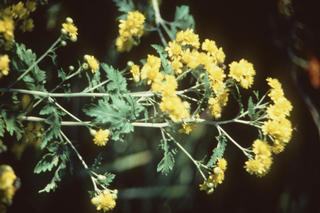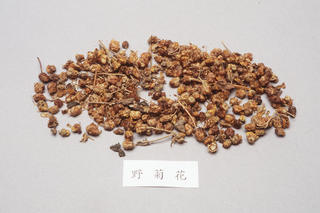Chrysanthemum indicum
Contents
Nomenclature
Other Names:
Historical Use of Chrysanthemum indicum
Chrysanthemum indicum in Traditional Chinese Medicine
Background
Chinese Name (pinyin): Yejuhua
Chinese Name :
Common Name :Wild Chrysanthemum Flower
Specific Name : Flos chrysanthemi indici
Scientific Name:
Collection : The drug is collected at the early stage of flowering in autumn and winter and dried in the sun or dried after steaming.
Description : Subspherical, 0.3 - 1cm in diameter, brownish yellow. Involucre consisting of 4 - 5 rows of bracts, the outer bracts oval or strip shaped, the outer surface greyish green or pale brown in the center, often covered with white hairs, margin scarious, the inner bracts elongated elliptical, scarious, hairs absent on the outer surface. Remaining pedicel at the base of involucre, ligulate florets 1 whorl, yellow, crumpled and rolled, tubular florets numerous, deep yellow. Texture light, odour aromatic, taste bitter.
Identification : 3g of the powder add 40ml of ethanol, heat under reflux for 1 hour and filter. The filtrate complies with the following tests.1.Apply 1 drop of the fiultrate to filter paper, spray with aluminum chloride TS, after dryness examine under ultra violet light (365nm), a yellow green fluorescence is observed.2.2ml of the filtrate add a small quantity of magnesium powder and 4-5 drops of hydrochloric acid, heat. A reddish brown color is produced.
Processing :
Action : To remocve toxic heat.
Indication : boils, carbuncles, inflammation of the eye, headache and dizziness
Precautions :
Dosage : 9 to 15 g; for external use, appropriate quantity to be made decoction for washing or made into ointment for topical application.
Storage : Preserve in a cool and dry place, protected from moisture and moth.
Nomenclature
Other Names:
Historical Use of Chrysanthemum indicum
Chrysanthemum indicum in Traditional Chinese Medicine
Background
Chinese Name (pinyin): Yejuhua
Chinese Name :
Common Name :Wild Chrysanthemum Flower
Specific Name : Flos chrysanthemi indici
Scientific Name:
Collection : The drug is collected at the early stage of flowering in autumn and winter and dried in the sun or dried after steaming.
Description : Subspherical, 0.3 - 1cm in diameter, brownish yellow. Involucre consisting of 4 - 5 rows of bracts, the outer bracts oval or strip shaped, the outer surface greyish green or pale brown in the center, often covered with white hairs, margin scarious, the inner bracts elongated elliptical, scarious, hairs absent on the outer surface. Remaining pedicel at the base of involucre, ligulate florets 1 whorl, yellow, crumpled and rolled, tubular florets numerous, deep yellow. Texture light, odour aromatic, taste bitter.
Identification : 3g of the powder add 40ml of ethanol, heat under reflux for 1 hour and filter. The filtrate complies with the following tests.1.Apply 1 drop of the fiultrate to filter paper, spray with aluminum chloride TS, after dryness examine under ultra violet light (365nm), a yellow green fluorescence is observed.2.2ml of the filtrate add a small quantity of magnesium powder and 4-5 drops of hydrochloric acid, heat. A reddish brown color is produced.
Processing :
Action : To remocve toxic heat.
Indication : boils, carbuncles, inflammation of the eye, headache and dizziness
Precautions :
Dosage : 9 to 15 g; for external use, appropriate quantity to be made decoction for washing or made into ointment for topical application.
Storage : Preserve in a cool and dry place, protected from moisture and moth.
Synonymns for Chrysanthemum indicum
Patent Medicines and Medicines with Multiple Ingredients that include Chrysanthemum indicum
Pharmaceutical Information
Chemical Constituents
Evidence or the Use of Chrysanthemum indicum in the Treatment of Epilepesy
Basic Science
Animal Studies
Cohort, Case-Control and Non-Randomized Trials
Randomized Controlled Trials
Meta-Analysis
1st Five Results: pubmed search

